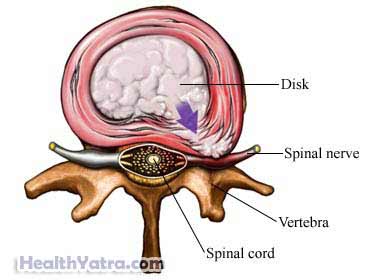परिभाषा
Discs are small circular cushions between the bones in the spine. The bones are called vertebrae. The discs are compressible. They act as cushions for the vertebrae. A herniated disc happens when discs in the spine bulge from their proper place. This is most common in the lower spine.

का कारण बनता है
Herniated discs can occur when discs lose water content, become flatter, and provide less cushioning. If they become too weak, the outer part may tear. The inside part of the disc may then push through the tear. This can put pressure on the nerves next to the disc.
जोखिम कारक
These factors increase your chance of developing a herniated disc:
- Age: 30s and 40s
- Trauma from a fall, accident, or sudden twisting
- Strain on the back—either repeated or sudden (as from lifting a heavy weight)
- Certain jobs that require heavy lifting
लक्षण
लक्षणों में शामिल हैं:
- Pain—how severe the pain is depends on which disc is herniated and how large the herniation is
- Pain may spread over the buttocks, down the back of one thigh, and into the calf
- Pain may be in one leg (more common) or both legs
- Numbness, tingling, or weakness in the legs or feet
- Numbness, tingling, or weakness in one or both arms
- In severe cases, inability to find comfort even lying down
- Sudden aching or twisted neck that cannot be straightened without severe pain
- Cauda equina syndrome—involves bowel or bladder changes and/or numbness in the groin
- टिप्पणी: This is an emergency, Call 911
निदान
The doctor will ask about your symptoms and medical history. A physical exam will be done. Your spine will be examined. The doctor will test the movement, strength, and reflexes of the arms and legs.
उपचार
उपचार में शामिल हो सकते हैं:
Physical Medicine
- Bed rest
- During acute phase, back or neck massage and physical therapy to:
- Relax the neck or back muscles
- Decrease pain
- Increase strength and mobility
- Back and abdominal exercises during recovery phase
- Hot or cold packs—to reduce pain and muscle spasms
- Stretches for the spine:
- A doctor or chiropractor can sometimes help reduce pain by stretching your spine
- Any spinal manipulation must be done carefully by an experienced, licensed practitioner
- Traction (weights and pulleys)—to relieve pressure on the discs and keep you from moving around (more common for discs in the neck area)
- Neck collar or brace for a herniated disc in the neck—to relieve muscle spasms
दवाएं
आपका डॉक्टर लिख सकता है:
- Nonsteroidal anti-inflammatory drugs (NSAIDs)—to reduce inflammation and pain (such as, ibuprofen , naproxen )
- Muscle relaxants—to reduce muscle spasms
- दर्द की दवाएँ
Interventional Spine Care
- Steroid injections into the area around the nerve and disc. It is done to reduce pain and inflammation. The injections are used if other medications do not work.
- Minimally invasive procedures may include:
- Nucleoplasty
- Intradiscal electrothermy (IDET)
- Chemonucleolysis
सर्जरी
Surgery may be used for people who fail to respond to other treatments. Immediate surgery is necessary for cauda equina syndrome. Options include:
- Laminectomy—removal of some of the bone over the spine and of the problem disc
- Microdiskectomy—removal of fragments of herniated disc through a small incision (also known as intervertebral diskectomy)
- Spinal fusion—fusing of vertebrae (back bones) together with bone grafts or metal rods (rarely done for first-time disc problems)
रोकथाम
To help reduce your chances of getting a herniated disc, take the following steps:
- Practice good posture. Stand and sit straight, and keep your back straight when lifting.
- स्वस्थ वजन बनाए रखें.
- Exercise regularly. Ask your doctor about exercises to strengthen your back and stomach.
- Don’t wear high-heeled shoes.
- If you sit for long periods of time, use a stool to bring your knees above your hips.
